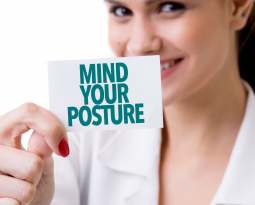
Productive Posture at Work in 3 Simple Steps
Give your workspace an ergonomic makeover and reap the benefits of better posture, better productivity, and less pain and discomfort at work. A recent poll determined that 86% of employees that work at a desk job were uncomfortable during work.
To design your unique postural presentation, you should design efficiency in places where you spend the most amount of time. Design your workspace in a way that supports and strengthens your postural framework, not fights it. Having proper ergonomics at work is a highly effective way of overcoming postural collapse in your typical daily settings.
The research is overwhelmingly in favor of the implementation of postural ergonomic programs in the workplace and your life space to improve health and vitality while preventing common musculoskeletal injuries. According to OSHA, poor posture at work results in 34% of all lost workday injuries and illnesses.
From the administrative perspective, research has repeatedly shown us that office ergonomics can improve worker productivity and wellbeing. A poll among employees determined that workers would be more pleasant on the job, more productive, and less stressed if their workspace design was ergonomically correct.
What many employees and employers may not know, is that they are actually putting their bodies at risk for early onset degeneration if they don’t take action to make their workspace a safe postural environment.
Your body is simply not designed to sit in the average workspace. The long-term benefits of proper posture and ergonomics demonstrate a significant return on investment in terms of financial gains and health benefits.
If you are like the majority of employees, your posture at work needs a makeover. Consider your workspace design and how you can make it more ergonomically efficient and comfortable for your body’s needs.
Fix Your Workspace in 3 Simple Steps
Sit tall and look straight ahead: By adjusting the level of your computer screen or laptop you can literally change your natural posture in an instant. The top of your computer screen should be eye level, allowing you to look forward comfortably as you work instead of looking down. By looking down for long periods of time, this creates excess tension on the muscles of the cervical spine and the shoulders. Over time, this creates a postural distortion pattern of the head, neck, and shoulders. To raise your computer monitor or laptop you can buy a lifter to adjust the height, or simply place a book underneath it.
Out with the old chair, and in with the exercise ball: Did you know that when you are in a seated position you increase the pressure in the lower back by about 1.7 times your body weight? And this is when you sit properly, if you slouch that pressure increases further. The spine is generally strong enough to tolerate the pressure of a slouched spine for about 20 minutes, before the vertebral discs start to absorb the pressure.
You may notice your back becoming stiffer throughout the course of the day to compensate for this pressure. Over time this can cause serious spinal degeneration with associated symptoms such as chronic back pain, herniated spinal discs, and sciatica.
To avoid weakening your lower back at work get rid of that old office chair and replace it with an exercise ball. Normal chairs make it difficult to sit upright with a straight spine. When sitting on an exercise ball proper posture comes naturally. Due to the design of the ball, you must engage and activate your core musculature while seated. This is highly beneficial as the core muscles support the lumbar spine.
The Keyboard Solution: Another common complaint among employees who work at a desk job is pain in their wrists and elbows, eventually leading to carpal tunnel syndrome. The solution to preventing this from happening to you is to consider the position in which your keyboard is placed.
If you are flexing your wrists all day everyday, this is causing serious strain to the ligaments, joints, muscles, and nerves of the forearm and hands. To correct this problem, position your keyboard in front of you- not too far away. You want to be able to keep your elbows at a comfortable 90-degree angle. The height of the desk should be at a height where you can place your hands flat on the keyboard and type in this manner. You want to avoid bending your wrists back and typing with your forearms flexed.
Yearly Posture Evaluation: In addition to having a properly designed workspace and proper posture at work, don’t forget the value of having your posture evaluated by an expert. Each year, everyone should have an annual postural evaluation with posture imaging to evaluate for the presence of early onset postural distortion patterns.
To find a Certified Posture Expert in your community, contact the American Posture Institute at www.AmericanPostureInstitute.com.

















